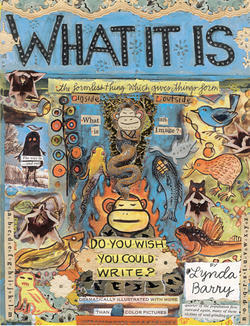Dan Kois, who reported on Lynda Barry’s teaching methods in a recent New York Times article kindly stopped by recently in our comments section. Here’s what he said:
I wrote the Lynda Barry piece in the Times Magazine, and have been reading this comment thread with great interest.
With regard to Barry and craft, I think it’s useful to separate her writing and her teaching. I think Lynda’s comics and novels do demonstrate that she has an interest in, and a flair for, the crafting of stories and scenes in ways that your average fiction-MFA instructor, for example, would appreciate.
In her teaching, though — at least as I witnessed it, and as she discussed it with me over many, many hours — I would argue that Lynda is, indeed, determinedly anti-craft, and in that regard, very very different from any writing teacher I’ve ever encountered, including in MFA programs where I’ve been a student or an instructor. There was a whole section of the piece that got cut for space that talked about the way that Lynda’s class deals heavily in inner process — that is, *where the ideas come from*, not just *how you craft the ideas into effective prose* — in a way that is anathema to nearly every creative writing teacher I’ve ever encountered. As the novelist and teacher Madison Smartt Bell told me, “I avoid that stuff like the plague, because it’s just too dangerous to deal with.” But Madison is of the opinion — as am I — that Lynda has found a method to teach inner process that is a) not damaging to students or dangerous to her and b) surprisingly effective for nearly everyone who takes her class.
To the commenter above who wrote:
>>But once Barry helps students open themselves up to their creativity, she does also advise them on editing and refining their work.That’s only true in a limited sense. She does discuss editing to some extent, but only in exceedingly broad terms. No students have their work edited in the class, because no students are allowed to discuss their work in the class, or even outside class, for the duration of the course. That’s a strict rule, and one that Lynda holds to herself; she wouldn’t even talk to me, a reporter, about any of her students’ work.
As I mention in passing in the article, Lynda makes the case in her class that narrative structure — that is, one major component of the craft of storytelling — is a natural muscle that most humans have. The example she gives is the way you tell a story depending on whether you have one minute to tell it or ten minutes to tell it; she points out that it’s a natural tendency to construct the details of a story in a manner appropriate for the space that one has to fill.
Now, do I think that Lynda has never once thought about story structure in writing her comics or (especially) her novels? No. (Though ask her about how she wrote CRUDDY and she’ll tell you a tale of years of woe stemming from reading book after book on story structure and novel-writing, which ended only when she threw it all away and painted the novel in ten months with a brush.) But I do think she holds firm in her teaching to a credo that for the students she’s working with, craft is not a useful thing to teach; in fact, craft gets in the way of the stories these students want to tell.

